Teledyne 4060 User Manual

INSTRUCTION, OPERATING AND MAINTENANCE MANUAL FOR
SERIES 4060
P/N M76417
DATE 06/29/10
DANGER
Toxic and/or flammable gases or liquids may be present in this monitoring system. Personal protective equipment may be required when servicing this instrument.
Hazardous voltages exist on certain components internally which may persist for a time even after the power is turned off and disconnected.
Only authorized personnel should conduct maintenance and/or servicing. Before conducting any maintenance or servicing, consult with authorized supervisor/manager.

Series 4060
Copyright © 2010 Teledyne Analytical Instruments
All Rights Reserved. No part of this manual may be reproduced, transmitted, transcribed, stored in a retrieval system, or translated into any other language or computer language in whole or in part, in any form or by any means, whether it be electronic, mechanical, magnetic, optical, manual, or otherwise, without the prior written consent of Teledyne Analytical Instruments, 16830 Chestnut Street, City of Industry, CA 91749-1580.
Warranty
This equipment is sold subject to the mutual agreement that it is warranted by us free from defects of material and of construction, and that our liability shall be limited to replacing or repairing at our factory (without charge, except for transportation), or at customer plant at our option, any material or construction in which defects become apparent within one year from the date of shipment, except in cases where quotations or acknowledgements provide for a shorter period. Components manufactured by others bear the warranty of their manufacturer. This warranty does not cover defects caused by wear, accident, misuse, neglect or repairs other than those performed by Teledyne or an authorized service center. We assume no liability for direct or indirect damages of any kind and the purchaser by the acceptance of the equipment will assume all liability for any damage which may result from its use or misuse.
We reserve the right to employ any suitable material in the manufacture of our apparatus, and to make any alterations in the dimensions, shape or weight of any parts, in so far as such alterations do not adversely affect our warranty.
Important Notice
This instrument provides measurement readings to its user, and serves as a tool by which valuable data can be gathered. The information provided by the instrument may assist the user in eliminating potential hazards caused by his process; however, it is essential that all personnel involved in the use of the instrument or its interface be properly trained in the process being measured, as well as all instrumentation related to it.
The safety of personnel is ultimately the responsibility of those who control process conditions. While this instrument may be able to provide early warning of imminent danger, it has no control over process conditions, and it can be misused. In particular, any alarm or control systems installed must be tested and understood, both as to how they operate and as to how they can be defeated. Any safeguards required such as locks, labels, or redundancy, must be provided by the user or specifically requested of Teledyne at the time the order is placed.
Therefore, the purchaser must be aware of the hazardous process conditions. The purchaser is responsible for the training of personnel, for providing hazard warning methods and instrumentation per the appropriate standards, and for ensuring that hazard warning devices and instrumentation are maintained and operated properly.
Teledyne Analytical Instruments, the manufacturer of this instrument, cannot accept responsibility for conditions beyond its knowledge and control. No statement expressed or implied by this document or any information disseminated by the manufacturer or its agents, is to be construed as a warranty of adequate safety control under the user’s process conditions.
ii |
Teledyne Analytical Instruments |
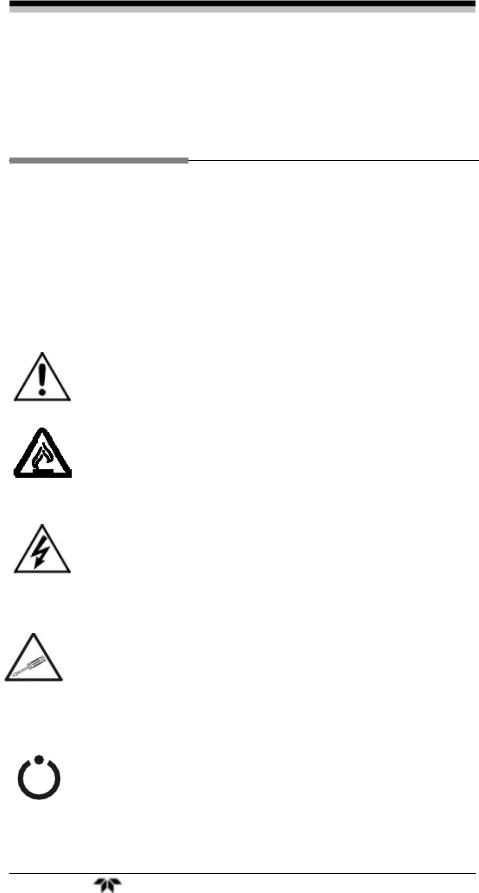
Series 4060
Safety Messages
Your safety and the safety of others is very important. We have provided many important safety messages in this manual. Please read these messages carefully.
A safety message alerts you to potential hazards that could hurt you or others. Each safety message is associated with a safety alert symbol. These symbols are found in the manual and inside the instrument. The definition of these symbols is described below:
No
Symbol
GENERAL WARNING/CAUTION: Refer to the instructions for details on the specific danger. These cautions warn of specific procedures which if not followed could cause bodily Injury and/or damage the instrument.
CAUTION: HOT SURFACE WARNING: This warning is
specific to heated components within the instrument. Failure to heed the warning could result in serious burns to skin and underlying tissue.
WARNING: ELECTRICAL SHOCK HAZARD: Dangerous
voltages appear within this instrument. This warning is specific to an electrical hazard existing at or nearby the component or procedure under discussion. Failure to heed this warning could result in injury and/or death from electrocution.
Technician Symbol: All operations marked with this symbol are to be performed by qualified maintenance personnel only.
NOTE: Additional information and comments regarding a specific component or procedure are highlighted in the form of a note.
STAND-BY: This symbol indicates that the instrument is on Stand-by but circuits are active.
Teledyne Analytical Instruments |
iii |

Series 4060
CAUTION: THE ANALYZER SHOULD ONLY BE USED FOR THE PURPOSE AND IN THE MANNER DESCRIBED IN THIS MANUAL.
IF YOU USE THE ANALYZER IN A MANNER OTHER THAN THAT FOR WHICH IT WAS INTENDED, UNPREDICTABLE BEHAVIOR COULD RESULT POSSIBLY ACCOMPANIED WITH HAZARDOUS CONSEQUENCES.
This manual provides information designed to guide you through the installation, calibration and operation of your new analyzer. Please read this manual and keep it available.
Occasionally, some instruments are customized for a particular application or features and/or options added per customer requests. Please check the front of this manual for any additional information in the form of an Addendum which discusses specific information, procedures, cautions and warnings that may be specific to your instrument.
Manuals do get misplaced. Additional manuals can be obtained from Teledyne at the address given in the Appendix. Some of our manuals are available in electronic form via the internet. Please visit our website at: www.teledyne-ai.com.
iv |
Teledyne Analytical Instruments |
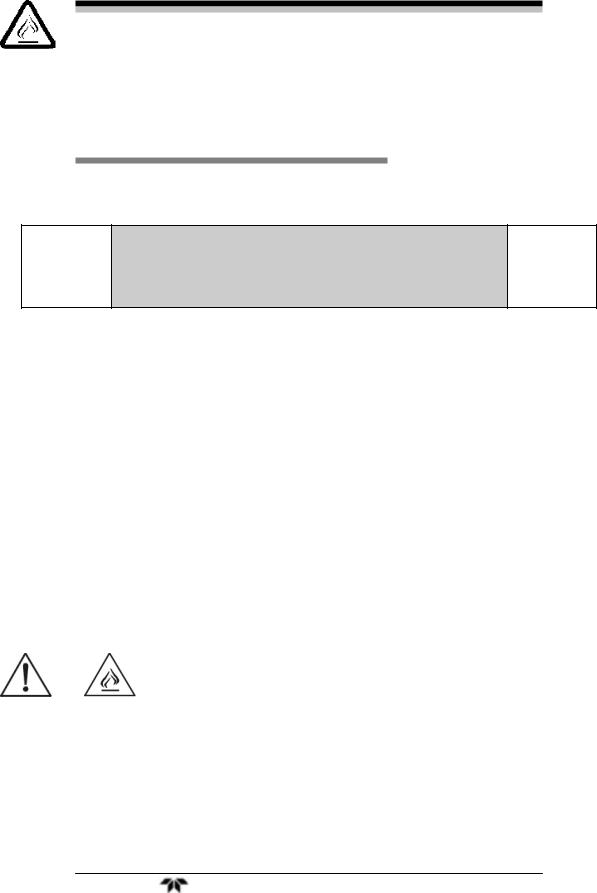
Series 4060
Additional Safety Information
DANGER
COMBUSTIBLE GAS USAGE
WARNING
This is a general purpose instrument designed for use in a non-hazardous area. It is the customer's responsibility to ensure safety especially when combustible gases are being analyzed since the potential of gas leaks always exist.
The customer should ensure that the principles of operating of this equipment are well understood by the user. Misuse of this product in any manner, tampering with its components, or unauthorized substitution of any component may adversely affect the safety of this instrument.
Since the use of this instrument is beyond the control of Teledyne, no responsibility by Teledyne, its affiliates, and agents for damage or injury from misuse or neglect of this equipment is implied or assumed.
WARNING: HYDROGEN GAS IS USED IN THIS INSTRUMENT AS A FUEL. HYDROGEN IS EXTREMELY FLAMMABLE. EXTREME CARE MUST BE USED WHEN WORKING AROUND GAS MIXTURES CONTAINING FLAMMABLE GASES.
A successful leak check was performed at TI/AI on the sample system of this instrument prior to calibration, testing and shipping. Ensure that there are no leaks in the fuel supply lines before applying power to the system.
Teledyne Analytical Instruments |
v |

Series 4060
Always purge the entire system before performing any maintenance and always leak check the system after removing any tubing or fittings on the sample system. See the procedures for purging and leak checking this instrument on the following pages.
If toxic gases or other hazardous materials are introduced into the sample system, the same precautions regarding leak checking and purging apply to the sample lines and sample supply or delivery lines.
WARNING: ELECTRICAL SHOCK HAZARD. WITH THE EXCEPTION OF OPENING THE DOOR AND ADJUSTING THE PRESSURE REGULATORS, FLOW CONTROLLER, OR OBSERVING THE PRESSURE GAUGES AND THE FLOWMETER, ONLY AUTHORIZED AND SUITABLY TRAINED PERSONNEL SHOULD PERFORM WORK INSIDE OF THE INSTRUMENT. COMPONENTS WITHIN THE COVER ON THE INSIDE OF THE DOOR, INSIDE THE ISOTHERMAL CHAMBER (SAMPLE SYSTEM), AND ON THE ELECTROMETER-AMPLIFIER PC BOARD CONTAIN DANGEROUSLY HIGH VOLTAGE SUFFICIENT TO CAUSE SERIOUS INJURY OR DEATH.
There are the following three types of inaccessible shock hazards within the Analyzer:
1.Line voltages and line related voltages such as 115 VAC which exists within the 230 VAC versions as well. These voltages stop when the Analyzer is turned off and the mains (line) cord is removed from the instrument.
2.The sensor anode supply voltage (approximately 250 VDC). This voltage exists on the Flame Guard, anode power supply, PCB, the motherboard, and the anode/igniter terminals on the sensor. THIS VOLTAGE WILL REMAIN HAZARDOUS FOR MANY MINUTES AFTER THE ANALYZER HAS BEEN TURNED OFF!
vi Teledyne Analytical Instruments
Teledyne Analytical Instruments
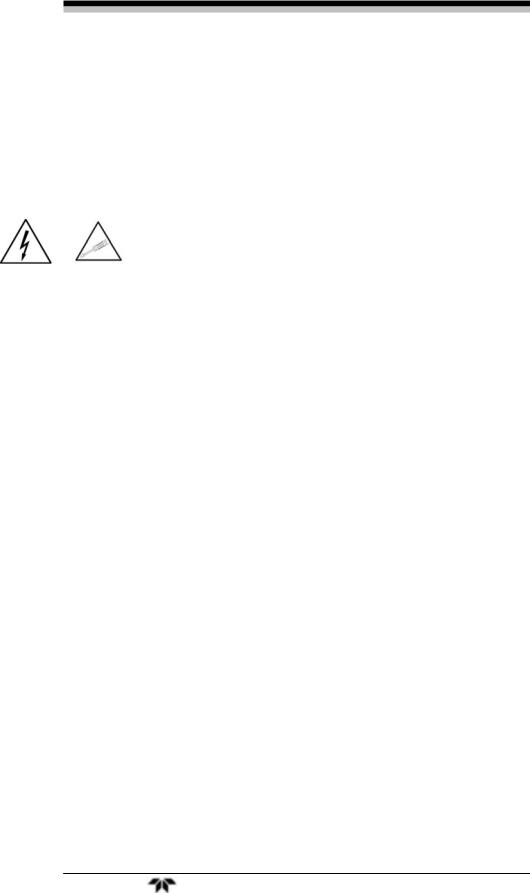
Series 4060
3.External hazardous voltages which may be connected to the Analyzer alarm relay connections.
Procedure for Removal of Internal Inaccessible Shock Hazards
CAUTION: SERVICING OR MAINTENANCE OF THE ANALYZER SHOULD ONLY BE DONE BY SUITABLE TRAINED PERSONNEL. TO AVOID THESE INACCESSIBLE HAZARDOUS VOLTAGES WHEN SERVICING THE SERIES 4060, PERFORM EACH OF THE FOLLOWING STEPS, IN THE ORDER GIVEN, BEFORE SERVICING BEGINS:
1.Switch off the power to the Analyzer and remove the main (line) power cord from the Analyzer.
2.Remove all external voltages from the connections to the alarm contacts.
3.Wait one minute.
4.Discharge the anode supply voltage.
a.Connect one end of an insulated (to 1000 VDC or more) clip lead to Analyzer chassis ground (the standoff for the upper right corner of the mother PCB).
b.Put one end of a 500V rated 1000 ohm resistor in the other end of the clip lead.
c.Check the voltage between chassis ground (the standoff for the upper right corner of the mother PCB) and the top side of R2 at PCB number B74671. It should be between -5VDC and +5VDC. If is in that range, the inaccessible hazardous voltage removal procedure is completed, if not repeat steps 4.a and 4.b.
If it is absolutely necessary to work inside the instrument with power on, use the ONE HAND RULE:
Work with one hand only.
Keep the other hand free without contacting any other object. This reduces the possibility of a ground path through the body in case of accidental contact with hazardous voltages.
Teledyne Analytical Instruments |
vii |

Series 4060
WARNING: THIS INSTRUMENT IS DESIGNED TO BE OPERATED IN A NONHAZARDOUS AREA. THE ANALYZER USES HYDROGEN GAS AND/OR OTHER COMBUSTIBLE GASES IN ITS OPERATION. THIS EQUIPMENT, IF NOT USED AND MAINTAINED PROPERLY CAN BE AN EXPLOSION HAZARD. THE ANALYZER, DEPENDING ON THE APPLICATION, MAY ALSO USE TOXIC GASES. IT IS THEREFORE, THE CUSTOMER'S RESPONSIBILITY TO ENSURE THAT PROPER TRAINING AND UNDERSTANDING OF THE PRINCIPLES OF OPERATION OF THIS EQUIPMENT ARE UNDERSTOOD BY THE USER. SINCE THE USE OF THIS INSTRUMENT IS BEYOND THE CONTROL OF TELEDYNE, NO RESPONSIBILITY BY TELEDYNE, ITS AFFILIATES AND AGENTS FOR DAMAGE OR INJURY RESULTING FROM MISUSE OR NEGLECT OF THIS INSTRUMENT IS IMPLIED OR ASSUMED. MISUSE OF THIS PRODUCT IN ANY MANNER, TAMPERING WITH ITS COMPONENTS OR UNAUTHORIZED SUBSTITUTION OF ANY COMPONENT MAY ADVERSELY AFFECT THE SAFETY OF THIS INSTRUMENT.
CAUTION: WHEN OPERATING THIS INSTRUMENT, THE DOORS MUST BE CLOSED AND ALL COVERS SECURELY FASTENED. THE GAUGES MUST BE IN PROPER WORKING ORDER. DO NOT OVERPRESSURIZE THE SYSTEM.
READ THIS MANUAL BEFORE OPERATING THE
INSTRUMENT AND ADHERE TO ALL WARNINGS
INCLUDED IN THIS MANUAL.
viii |
Teledyne Analytical Instruments |

Series 4060
Table of Contents |
|
|
Safety Messages .......................................................................... |
iii |
|
Additional Safety Information ...................................................... |
v |
|
List of Figures............................................................................. |
xiii |
|
List of Tables .............................................................................. |
xiv |
|
Introduction ................................................................................. |
15 |
|
1.1 |
Main Features of the Analyzer |
15 |
1.2 |
Principle of Operation |
16 |
1.3 |
Analyzer Description |
16 |
1.4 |
Applications |
18 |
Operational Theory ..................................................................... |
19 |
|
2.1 |
Introduction |
19 |
2.2 |
Modes of Operation |
19 |
2.3 |
Analyzer Subsystems |
20 |
|
2.3.1 Sample System |
20 |
|
2.3.2 Gas Flow Control System |
21 |
|
2.3.3 Fuel and Blanket Air Systems |
22 |
|
2.3.4 Flame Ionization Detection Cell |
22 |
2.4 |
Detection Cell |
24 |
|
2.4.1 Electrometer-Amplifier |
25 |
|
2.4.2 Anode Power Supply |
26 |
|
2.4.3 Flame Guard Circuit |
26 |
|
2.4.4 Flame Ignition Circuit |
26 |
Installation ................................................................................... |
27 |
|
3.1 |
Unpacking the Analyzer |
27 |
3.2 |
Mounting the Analyzer |
27 |
|
Teledyne Analytical Instruments |
ix |

Series 4060
3.3 User Connections |
28 |
|
3.3.1 Electrical Power Connections |
28 |
|
3.3.2 Electronic Connections |
28 |
|
3.3.2.1 Primary Input Power |
29 |
|
3.3.2.2 Fuse Installation |
30 |
|
3.3.2.3 |
50-Pin Equipment Interface Connector |
30 |
3.3.2.4 |
Analog Output |
30 |
3.3.2.5 |
Alarm Relays |
32 |
3.3.2.6 |
Digital Remote Cal Inputs |
34 |
3.3.2.7 |
Range ID Relays |
35 |
3.3.2.8 |
Network I/O |
35 |
3.3.2.9 Pin Out Table |
35 |
|
3.3.2.10 RS-232 Port |
36 |
|
3.3.3 Gas Connections |
37 |
|
3.3.3.1 Effluent |
40 |
|
3.3.3.2 Sample Bypass Vent |
40 |
|
3.3.3.3 Fuel and Air Connections |
40 |
|
3.3.3.4 Sample and Span Gas Connections |
40 |
|
3.4 Placing the System in Operation |
40 |
|
Operation ..................................................................................... 41 |
||
4.1 Equipment |
|
41 |
4.2 Preliminary Power-Off Check List |
42 |
|
4.3 Activating the Support Gases |
42 |
|
4.3.1 Air |
|
43 |
4.3.2 Carrier Gas |
43 |
|
4.3.3 Span Gas |
43 |
|
4.3.4 Fuel |
|
43 |
4.4 Flame Ignition |
43 |
|
4.4.1 Verification of the Flame Guard Circuit |
44 |
|
4.4.2 Ignition and/or Flame Guard Circuit Failure |
44 |
|
x |
Teledyne Analytical Instruments |

Series 4060
4.5 Sample Pump |
44 |
4.6 Analyzer Operation |
44 |
4.6.1 Default Parameters |
46 |
4.6.2 Style Conventions |
46 |
4.6.3 Navigation and Data Entry |
47 |
4.6.3.1 Arrow Keys |
47 |
4.6.3.2 ENTER |
47 |
4.6.3.3 ESCAPE |
48 |
4.6.4 Menu Structure |
48 |
4.6.4.1 Main Menus |
49 |
4.6.5 Span |
50 |
4.6.6 ALT-SPAN |
51 |
4.6.7 The Model Screen |
51 |
4.6.8 System Self-Diagnostic Test |
51 |
4.6.9 The Alarms Function |
52 |
4.6.10 The Range Function |
55 |
4.6.11 Analog Output Adjustment |
55 |
4.6.12 Linearization |
56 |
4.6.13 Changing Stream |
56 |
4.6.14 Setting up an AUTO-CAL |
56 |
4.6.15 Timing |
58 |
4.6.16 Group Setup |
58 |
4.6.17 Password Protection |
58 |
4.6.18 Logging Out |
61 |
4.6.19 Standby |
62 |
Maintenance & Troubleshooting................................................ 65 |
|
5.1 Measuring Circuit Electrical Checks |
66 |
5.1.1 Anode Voltage Check |
66 |
5.1.2 Electronic Stability |
67 |
5.1.3 Printed Circuit Board Replacement |
67 |
Teledyne Analytical Instruments |
xi |

Series 4060
|
5.1.4 Collector Cable |
68 |
5.2 |
Temperature Control Electronic Check |
68 |
5.3 |
Ignition and/or Flame Guard Circuit Checks |
69 |
5.4 |
Sampling System |
70 |
5.5 |
Printed Circuit Board Descriptions |
71 |
|
5.5.1 Flame Guard and Anode Power Supply PCB |
71 |
|
5.5.2 Proportional Temperature Controller PCB |
72 |
|
5.5.3 Electrometer-Amplifier PCB |
73 |
Appendix...................................................................................... |
75 |
|
A.1 Specifications and Initial Settings: |
75 |
|
A.2 Recommended Spare Parts List |
76 |
|
A.3 Drawing List |
77 |
|
Appendix B .................................................................................. |
79 |
|
B1 Addendum and Testing Results |
79 |
|
xii |
Teledyne Analytical Instruments |

Series 4060
List of Figures
Figure 1-1: Model 4060 |
Front Panel Interface ............................... |
17 |
Figure 1-2: Model 4060 |
Rear Panel .............................................. |
17 |
Figure 2-1: Internal Temperature Controllers ................................ |
21 |
|
Figure 2-2: Typical Piping Diagram for the Model 4060 ................ |
23 |
|
Figure 3-1: Model 4060 |
Rear Panel with Optional Gas Manifold... |
29 |
Figure 3-2: Equipment Interface Connector Pin Arrangement....... |
30 |
|
Teledyne Analytical Instruments |
xiii |

Series 4060
List of Tables |
|
Table 3-1: Analog Output Connections ......................................... |
31 |
Table 3-2: Analog Concentration Output—Example ..................... |
31 |
Table 3-3: Analog Range ID Output—Example............................. |
32 |
Table 3-4: Alarm Relay Contact Pins ............................................ |
33 |
Table 3-5: Remote Calibration Connections.................................. |
34 |
Table 3-6: Range ID Relay Connections....................................... |
35 |
Table 3-7: Pin out of 50 pin D-Sub Connector............................... |
36 |
Table 3-8: Commands via RS-232 Input ....................................... |
37 |
Table 3-9: Required RS-232 Options ............................................ |
37 |
xiv |
Teledyne Analytical Instruments |

Series 4060 |
Introduction |
|
|
|
|
|
|
|
Introduction
Teledyne Analytical Instruments Series 4060, Trace Aromatic Hydrocarbon Analyzer, is a versatile instrument designed to measure the quantity of aromatic hydrocarbons, primarily benzene, present in a positive pressure sample gas. The analyzer is a microprocessor controlled digital instrument based on Teledyne’s highly successful Model 402R series analog Total Hydrocarbon Analyzer, coupled with a gas separation column and a switching valve. The basic analyzer allows for the measurement of benzene in the low ppb range. The Analyzer also allows the diagnostic capability to look for other aromatics, like toluene, ethyl benzene and xylenes. Other versions of Series 4060 allowing for dual measurements are also available. Contact the factory for further detail.
1.1 Main Features of the Analyzer
The Analyzer is sophisticated yet simple to use. A dual display on the front panel prompts and informs the operator during all phases of operation. The main features of the analyzer include:
Easy-to-use front panel interface that includes a red 5-digit LED display and a vacuum fluorescent display (VFD), driven by microprocessor electronics.
High resolution, accurate readings of concentration.
Versatile analysis with three user-definable analysis ranges.
Microprocessor based electronics: 8-bit CMOS microprocessor with 32 kB RAM and 128 kB ROM.
Auto ranging allows analyzer to automatically select the proper preset range for a given measurement. Manual override allows the user to lock onto a specific range of interest.
Two adjustable concentration alarms and a system failure alarm.
Teledyne Analytical Instruments |
15 |

Introduction |
Series 4060 |
|
|
|
|
|
|
|
Extensive self-diagnostic testing at startup and on demand with continuous power supply monitoring.
RS-232 serial digital port for use with a computer or other digital communication device.
Analog outputs for concentration and range identification (0- 1 VDC standard and isolated 4-20 mA dc).
Superior Accuracy
1.2Principle of Operation
The analyzer uses a gas separation column to separate the component of interest, like benzene, from the other hydrocarbons in the sample gas. Using a carrier gas and a microprocessor actuated switching valve, the eluted gas is analyzed in Flame Ionization Detector (FID) and the column is back flushed to accept the fresh sample in the next cycle. More information is provided in Section 2.1 Introduction, under Operational Theory. The electrical output of the electrometer-amplifier is directly proportional to the concentrations of the ionizable hydrocarbons present over the ranges of interest.
1.3 Analyzer Description
The standard analyzer is a rack mountable instrument designed to fit into a standard 19” instrument rack. The front interface panel is mounted on a door which, when opened, allows convenient access to the Analyzer electronics. The entire front panel can slide out of the chassis to provide greater access to the electronics and to the sample system. Gas pressure and flow controls are mounted on the front panel adjacent to the LED and VFD displays and user interface.
At the rear of the instrument are ports for the introduction of air, fuel, zero, span, and sample gas. A single 50-pin user-interface cable connector contains input/output and alarm signals available to the user. An RS-232 port is also available at the rear panel for connection to a remote computer or other digital communication device. The Analyzer is set up for either 120 VAC 60 Hz or 230 50/60 Hz operation depending on the customer’s requirements. The appropriate power cord for your unit has been shipped with this instrument.
Figure 1-1 shows the Model 4060 front interface while Figure 1-2 shows the rear panel including the user connections.
16 |
Teledyne Analytical Instruments |
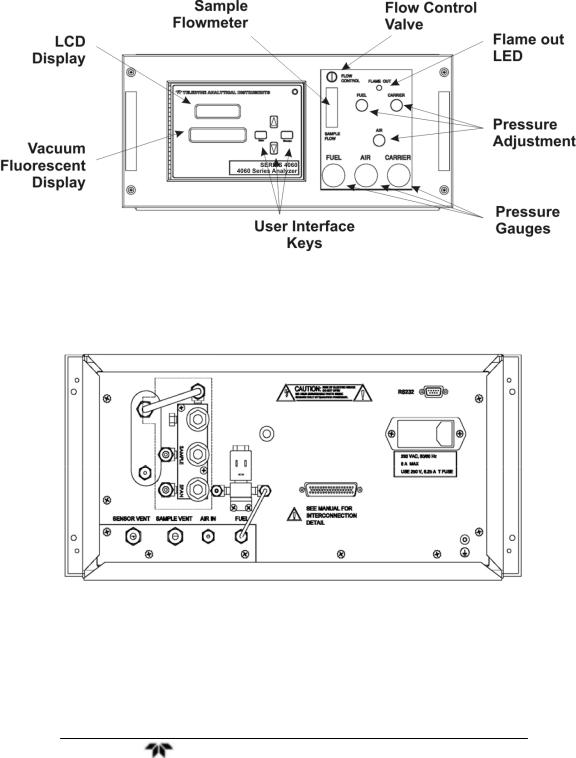
Series 4060 |
Introduction |
|
|
|
|
|
|
|
Figure 1-1: Model 4060 Front Panel Interface
Figure 1-2: Model 4060 Rear Panel
Teledyne Analytical Instruments |
17 |

Introduction |
Series 4060 |
|
|
|
|
|
|
|
1.4Applications
Monitoring the benzene concentration of carbon dioxide gas for use in the beverage industry.
Monitoring aromatic contamination in air liquefaction and other gas production processes.
Gas purity certification.
Detecting trace benzene in ambient air.
Detecting atmospheric pollutants.
18 |
Teledyne Analytical Instruments |

Series 4060 |
Operational Theory |
|
|
|
|
|
|
|
Operational Theory
2.1 Introduction
Series 4060 Analyzer for Benzene uses a FID detector and a Gas Chromatograph (GC) Column. Using a carrier gas and a microprocessor actuated switching valve, a fixed volume of sample is pushed into the Column maintained at a constant temperature. The eluted gas is analyzed for benzene in a FID detector and the column is back flushed to accept the fresh sample in the next cycle. Actual separating and detecting sequence may vary depending on compounds of interest in the application for which the analyzer is configured.
The Series 4060 Analyzer uses a flame ionization detector to sense benzene. The FID was selected based on the positive performance and extensive experience in the use of this detector in other Teledyne analyzers namely Model 402R and Model 4020. The FID has proven itself to be a rugged, stable, long life sensor giving years of trouble free operation in various applications. Also considering the fact that the required sensitivity of 100 ppb full scale was achieved, FID was considered a better choice over the limited life and less reliable Photo Ionization Detector.
A stainless steel packed column containing Chromosorb Diatomite was used at a constant temperature of 70 C. Using nitrogen as a carrier gas and a 5 ml sample loop, benzene elutes from the column within a few minutes. Additionally, a clear separation is observed from other aromatic hydrocarbons, namely toluene, ethyl benzene, and xylenes. The actual temperature setpoint and compound separation for your instrument may be different depending on the application. It is listed in the Addendum and Testing Results section of Appendix B.
2.2 Modes of Operation
The analyzer has 2 modes of operation depending on the position of the GC Sampling Valve (See Piping Diagram in Figure 2-2). They are: Sample Mode (position A) and Analysis Mode (position B).
Teledyne Analytical Instruments |
19 |

Operational Theory |
Series 4060 |
|
|
|
|
|
|
|
1.Valve Position A—Sampling Mode
In this mode the analyzer configures the operational valve to back flush the column and charge the sample loop. The Sample Mode is programmed to continue for a 7 minute period by factory default; however, it is usually modified to match the needs of a particular process. The specific timing interval for your system is listed in the Addendum and Testing Results section of Appendix B. It is possible to set the Sample Mode duration up to 25 minutes.
2.Valve Position B—Analysis Mode
In this mode the analyzer configures the sampling valve to feed the gas in the sample loop through the column and to the detector. The eluted sample from the column is fed to the FID for the analysis of the compound of interest in the hydrocarbon stream. If configured to do so, the analyzer may read the detector for a programmed 5 second period at some point within this mode cycle to obtain a baseline reading for further calculation. This mode is usually programmed to continue until the compound of interest is fully eluted from the column. It is possible to set it up to 25 minutes.
During the Analysis Mode, a ‘Peak Detect’ period is programmed at which time the analyzer reads the detector output. The analyzer integrates the peak area during this time in conjunction with the baseline settings to calculate the concentration of the compound of interest. The calculation is performed at the end of the ‘Peak Detector’ period and the result is displayed at the end of Analysis Mode.
2.3 Analyzer Subsystems
The Model Analyzer is composed of three subsystems:
1.Sample System
2.Detector Cell
3.Electronic Signal Processing, Display and Control
2.3.1 Sample System
All components used to control the sample and supporting gases, as well as the combustion portion of the detector cell, are located inside the
20 |
Teledyne Analytical Instruments |
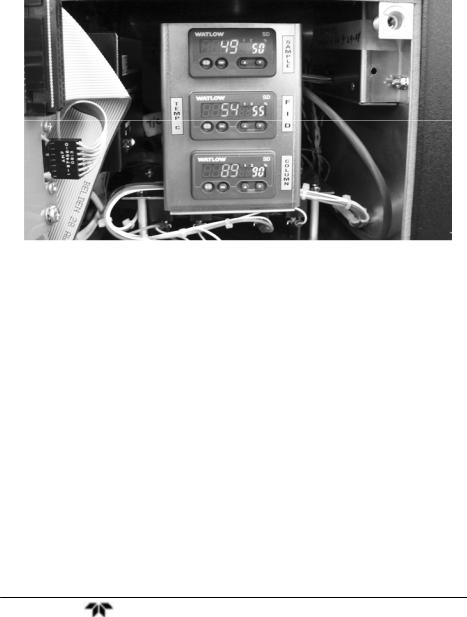
Series 4060 |
Operational Theory |
|
|
|
|
|
|
|
analyzer chassis. They are accessible by opening the front door of the analyzer.
Adjustments are made using the appropriate control on the front panel.
The analyzer contains three separate isothermal chambers ‘SAMPLE’, ‘FID’, and ‘COLUMN’ that are controlled by individual PID temperature controllers. These controllers with integral readout display are visible just behind the front panel as shown in Figure 2-1.
Figure 2-1: Internal Temperature Controllers
The sample chamber contains the 10-port GC switching valve and 2 sample loops. The ‘FID’ chamber contains the flame, pressure regulators, pressure gauges and flow restrictors used by the FID detector. The ‘COLUMN’ is housed in a separate ‘COLUMN’ enclosure and maintained at a temperature of 70° C by its PID temperature controller. The actual temperature setpoint for your instrument may be different depending on the application. It is listed in the Addendum and Testing Results section of Appendix B.
2.3.2 Gas Flow Control System
The analyzer is equipped with ports for the introduction of air, fuel, carrier gas, span, and sample gas. It is imperative that these gases are
Teledyne Analytical Instruments |
21 |

Operational Theory |
Series 4060 |
|
|
|
|
|
|
|
supplied at constant pressures using two stage stainless steel diaphragm gas regulators. The recommended pressure range is 30 to 80 psig, however, the span gas should be supplied at a pressure of 20 psig to the restrictor fitting either on the optional autocal module or the span inlet on the rear panel.
The Piping Diagram for the standard instrument is shown in Figure 2-2. A 10-port 2-position GC sampling valve is used to control and direct gas flows including sampling, back flush, and carrier gas. The fixed volume sample loop ensures the same volume of sample injection in the column every cycle.
If your instrument is fitted with the optional auto calibration module, a separate compartment containing of a pair of solenoid valves is installed for controlling the introduction of sample or span gas to the detector. Calibration can be performed automatically on a programmed schedule or manually using the front panel interface.
2.3.3 Fuel and Blanket Air Systems
Stable flow is achieved by maintaining a constant pressure across restrictors upstream from the cell. Each system incorporates an adjustable pressure regulator, pressure gauge, and restrictor. A flame out light is included to indicate when the flame fails. A fuel shut-off solenoid valve, mounted on the line that supplies fuel, stops the fuel flow in case of flame failure. This valve is located in line with the fuel port.
2.3.4 Flame Ionization Detection Cell
The carrier gas containing sample and fuel are combined within a tee fitting located in the isothermal chamber. The mixed gas is emitted from a burner within the sensor assembly. Blanket air is introduced into the sensor (or cell) by means of a separate fitting that is located in the base section of the assembly. The upper half of the assembly houses the anode-igniter, collector, and flame guard thermistor.
22 |
Teledyne Analytical Instruments |
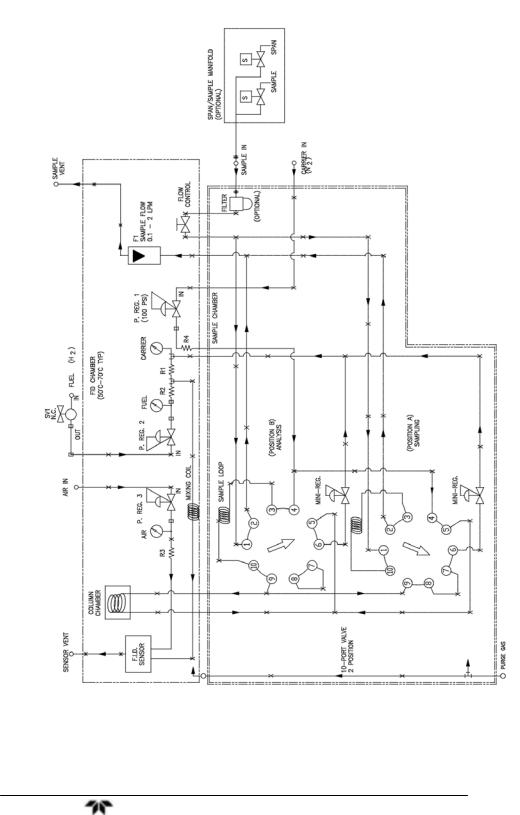
Series 4060 |
Operational Theory |
|
|
|
|
|
|
|
Figure 2-2: Typical Piping Diagram for the Model 4060
Teledyne Analytical Instruments |
23 |

Operational Theory |
Series 4060 |
|
|
|
|
|
|
|
2.4 Detection Cell
The upper section of the stainless steel flame ionization cell houses the cylindrical collector electrode, the high voltage (+260 VDC) anodeigniter coil, and the sensing thermistor of the flame guard circuit (see cell cross-section in Figure 2-3).
WARNING: DANGEROUS HIGH VOLTAGE EXISTS AT THE ANODE IGNITER COIL (+260 VDC). DO NOT ATTEMPT TO DISCONNECT THE IGNITER COIL CABLE OR DISASSEMBLE ANY OF THE FLAME IONIZATION CELL COMPONENTS WITHOUT TURNING OFF THE POWER AND DISCONNECTING THE POWER CORD.
The collector is interconnected with the electrometer-amplifier PC board by a coaxial cable. Although the cable and fittings are intended for coaxial service, the cable is actually being used as a shielded singleconductor connection.
The anode-igniter, as its name implies, serves two functions. When relay K2 at PCB part number B74671 is energized, the coil becomes an electrical heating element that glows red-hot and ignites the hydrogen fuel. When relay K2 at B74671 is de-energized, the coil is connected to the +260 volt DC terminal of the anode-flame guard power supply PC board. In this configuration, the necessary potential difference is established between the coil (anode) and collector to promote ionization of the burned hydrocarbons. The coil functions as the high voltage anode in all three-range positions of the selector switch.
The thermistor acts as the sensor in the flame guard circuit. Its ambient temperature resistance is in the 100 K ohms region. When the flame is ignited, its resistance is reduced by a factor of 100. The thermistor is coupled to a semiconductor control circuit on the anodeflame guard power supply PC board, which will be described in a following section.
The cell electrodes of both the anode-igniter and flame guard thermistor are connected to the electronics chassis by means of a plug-in cable.
The electrode section of the cell may be removed for inspection by turning off the power, disconnecting the electrode lead plug, and removing the screws, which retain the electrode assembly in the sensor body.
24 |
Teledyne Analytical Instruments |
